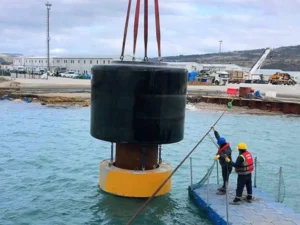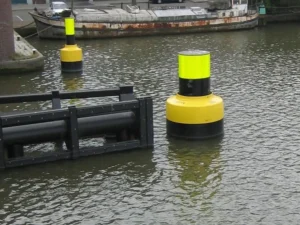Different types of marine fenders are available in the market. All of them differ in terms of their durability and maintenance costs. Donut fenders are prominent and offer 360-degree protection. However, due to their unique shape and design, many people need help understanding how to install and maintain donut fenders. It is accepted on all hands that donut fenders are super expensive. If you don’t maintain them regularly, they will deteriorate quickly. So, you’ll have to spend money again to buy them. To save you, this guide is dedicated to how to install and maintain donut fenders properly. So, let’s get started!
Structure & Design of Donut Fenders

Donut fenders are very useful in protecting ships and docking structures. They are popular because they offer 360-degree protection. Donut fenders inserted on columns or piles can easily rotate and protect the ships from every angle.
The structure and design of these fenders are unique. They are hollow from the center and have foam or rubber around the hollow point. In shape and design, they are just like donuts, so they are known as donut fenders.
Due to their unique design, their installation can be tricky at times. However, this design makes fenders function more effectively. There are different sizes of donut fenders available. Some are very small and used by local boat owners to protect boats. However, the mid-to-large-size donut fenders are used at a professional level.
The question is: which size should you choose? It depends on the size and diameter of the pile or column. The fenders will go onto the column, so they should be bigger than the diameter of the pile or column. A slightly bigger diameter will allow the fenders to rotate around the pile easily.
How to Install Donut Fenders?

Installation of donut fenders is tricky. This is due to the unique design and structuring of these fenders. However, you can do it with a few hits and trials with the right tools and skills. If you understand the installation mechanism, it will be easier for you to complete the process. Let’s discuss the steps you must follow to get the job done.
1- Arrange Tools and Devices
To install the donut fender, you’ll need some tools and devices. If you don’t arrange these tools, chances are high that you won’t be able to install these fenders. Here is the list of those must-have equipments:
- Lubricants
- Drill and drill bits
- Crane or lifting device
- Lifting slings or straps
- Wrenches and ratchets
- Measuring tape or laser measure
- Mounting hardware Brackets, clamps, or fasteners
These tools are mandatory, and compromising them would affect the installation process. You should also consider other gear, such as gloves and harnesses.
2- Evaluate the Pile or Column
Before starting the process, you must analyze the dimension of the column. The reason is that the fender will go onto this column. A slight miscalculation in these columns’ diameter will result in a problematic installation. If the diameter of the column is greater than the hollow structure of the fender, you won’t be able to fit it on the pile.
Once you have calculated the diameter of the column, choose the fender according to that diameter. This way, you’ll find the donut fender that fits or sits perfectly on the column. Never make the mistake of ordering the fender without evaluating and measuring the diameter.
3- Use Slings to Secure Fender
Once you find the fender, secure it with the slings or ropes. This will ensure that fenders won’t fall during the lifting process. Keep in mind that donut fenders are lifted to the height of piles. So, if you don’t secure it with ropes, it may fall off, resulting in damage.
4- Lift the Fender with Crane or Lifting Device
Once the fender is secured, you can lift it to the height of columns or piles. For this purpose, you can either use a crane or any other lifting device. However, make sure that lifting devices are strong enough to bear the weight of the donut fender.
During lifting, your crane operator should not be in a hurry. Instead, a straightforward approach with a calm mind must be followed. You must ensure the donut fender is above the column or piles. This will ensure that the fender goes in the correct position on the pile.
5- Attach the Fender to Pile
Once the fender and piles are perfectly aligned, you can start attaching and fitting the fender. You can use different brackets, fasteners, or mounting hardware for attachment. Keep in mind that this step is crucial and requires the utmost attention.
Slight mistakes can lead to severe issues. When fastening the fender, make sure that it remains slightly loose. This loose attachment will allow the fender to rotate around the piles. However, it should not be so loose that it offers weak protection.
6- Check the Rotation
Once the installation is complete, it’s time to test and check the fender’s workings. You can bring the ship close to this fender to check its rotation around the piles. If the vessel is unavailable, you can even hit the fender to check whether it rotates.
If you feel that the fender is rotating 360 degrees, it indicates the installation is completed. However, if you think there is an issue in rotation, you must readjust the bolts and fasteners. Keep testing until you find the perfect angle.
Quick Tip: Installing the donut fender is not easy and takes a lot of work. It will take some time before you complete the process. So, always keep your cool and follow the proper steps. Moreover, you should treat fenders gently so that they attach to the piles without any scratches.
Maintenance Tips for Donut Fenders

As I said earlier, donut fenders are expensive. If you leave them unchecked, they will deteriorate. However, by maintaining and taking care of them, you can increase their life. Let’s discuss some precautions and maintenance tips:
1- Check for Debris
One of the vital features of the donut fender is that it rotates around the piles. Sometimes, there can be debris between the fender and the pile. Due to this debris, the fenders fail to rotate efficiently. This affects the performance of the fenders. So, you should continually monitor and remove debris if there are any fenders and piles.
2- Wear & Tears
As you know, the donut fenders undergo extreme pressure when they collide with the ship at the docks. So, wear and tear are common. Keep an eye on donut fenders’ deterioration and quality issues. If you notice any damage, take immediate action to fix it. Slight negligence can lead to severe issues.
3- Washing with Freshwater
The fenders remain in the salty seawater, which can affect their quality. Remember that salt water can corrode the donut fender and significantly reduce lifespan. Therefore, I highly recommend washing your donut fenders with freshwater almost daily. This will help to remove salt buildup, if there is any.
4- Inspect for Corrosion
Corrosion is the worst enemy of the fenders. As they remain in salty sea water, the chances of rust are high. Therefore, you should look for rust on parts of the donut fenders. Usually, the attachment component of donut fenders gets rusty. You should apply grease or other lubricant to keep them in good shape.
5- Test the Rotation
The rotation of the donut fender around the pile is paramount. If this rotation is not smooth, it can lead to malfunctioning of fenders. Therefore, you must keep checking this rotation. If there is an issue, apply lubricant to ensure smooth rotation. The rotation is usually affected when debris is between the hollow structure of the donut fender and the pile.
Frequently Asked Questions?
What are donut fenders used for?
Donut fenders protect vessels and docking structures. When ships come close to the docking structure, they don’t directly collide with the docks. Instead, they collide with these fenders first. These donut fenders absorb the shock impact and save the docking structure from damage.
What makes donut fenders popular?
These fenders are known for their 360-degree protection. Their unique design allows them to be around cylindrical piles or columns. Thus, they protect ships and vessels no matter from what angle they approach the docks.
What materials are donut fenders made from?
Donut fenders are typically made from high-quality rubber or foam-filled materials. These materials are top-notch in terms of durability and strength. They effectively absorb the shock’s energy and offer resistance to harsh marine conditions.
How often should donut fenders be inspected and maintained?
There are no specific intervals for inspecting the fenders. I recommend you check them regularly; however, once every two weeks would be ideal. This will help you keep an active eye on their condition. Moreover, you should check them more frequently in high-traffic or harsh conditions.
What should I do if my donut fender stops rotating?
This usually happens when there is debris between the hollow structure of the donut fender and the pile. You should remove and clean that debris. Moreover, it would be best to look for other obstructions. To fix this issue, you should apply lubricant to the fenders so they rotate.
Conclusion
Donut fenders are a small component in the grand scheme. However, their performance is crucial for the safety of both vessels and docking structures. Installing these fenders on the column or pile is tedious and complex.
Many people, even professionals, need help understanding the process. So, this guide covers everything from the design of the donut fenders to their installation. Fenders are expensive, so we also discussed different ways to maintain them. Those tips will prevent your fenders from deteriorating.
